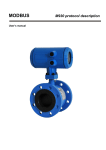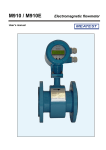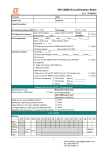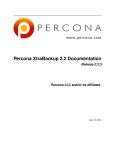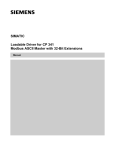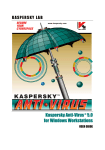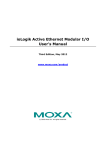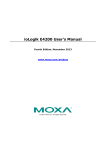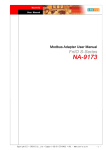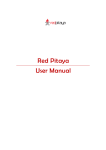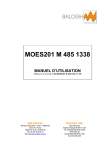Download M920 Modbus - meatest.cz
Transcript
MODBUS User’s manual M920 protocol description MODBUS protocol CONTENT 1. 2. BASIC INFORMATION 1.1. INTRODUCTION TO M ODBUS 1.2. TRANSMISSION FORMAT 1.2.1. ASCII-MODE 1.2.2. RTU-MODE 4 4 4 5 SUPPORTED FUNCTIONS 7 2.1. 2.2. 2.3. 2.4. 2.5. 2.6. 3. 4 READ COIL STATUS (FUNCTION 01) READ INPUT STATUS (FUNCTION 02) READ MULTIPLE HOLDING REGISTERS (FUNCTION 03) READ INPUT REGISTERS (FUNCTION 04) WRITE SINGLE COIL (FUNCTION 05) WRITE MULTIPLE HOLDING REGISTERS (FUNCTION 16) 7 7 7 7 7 7 COMMANDS TABLE 3.1. 3.2. 3.3. 3.4. 3.5. 3.6. 3.7. 3.8. 8 TABLE 1 B IT VARIABLES (SINGLE COILS ) TABLE 2 INTEGER VARIABLES (HOLDING REGISTERS ) TABLE 3 LONG VARIABLES (HOLDING REGISTERS ) TABLE 4 TIME (LONG) VARIABLES (HOLDING REGISTERS ) TABLE 5 CHAR VARIABLES (HOLDING REGISTERS ) TABLE 6 FLOAT VARIABLES (HOLDING REGISTERS ) TABLE 7 STRING VARIABLES (HOLDING REGISTERS ) TABLE 8 DOUBLE VARIABLES (HOLDING REGISTERS ) Operation manual 8 9 9 10 10 11 12 13 3 MODBUS protocol 1. Basic information 1.1. Introduction to Modbus This document specifies the MODBUS communications protocol as implemented on the magnetic flowmeter M920. This manual does not try to be a complete guide to the MODBUS protocol, but will show how to structure a message that the instruments will recognize. For Modbus communication is used RS-485 interface. Instruments communicate using a master-slave technique, in which only one device is the master and theslave devices supply the requested data when addressed. Typical master devices can be a host computer. Only the master can initiate transactions (requests), and only the addressed device responds. The Modbus request consist of: • an address, • a function code defining the requested action, • data (if necessary for the requested function), and • error check for testing the integrity of the message. The slave’s response contains: • the slave address, • data conform the request type, and • error check. If the data integrity test fails, no response is sent back. If a request cannot be processed an exception message is returned. 1.2. Transmission format There are two serial transmission modes for the MODBUS protocol, ASCII or RTU (Remote Transmission Unit) framing. The user has to select the desired protocol along with the serial communication parameters (baud rate, paritytype). Note that all these parameters must be the same for all instruments in the network. 1.2.1. ASCII-mode When device communicate on a MODBUS serial line using ASCII mode, each 8–bit byte in a message is sent as two ASCII characters. This mode is used when the physical communication link or the capabilities of the device does not allow the conformance with RTU mode requirements regarding timers management. Remark : this mode is less efficient than RTU since each byte needs two characters. The format ( 10 bits ) for each byte in ASCII mode is : Coding System: Hexadecimal, ASCII characters 0–9, A–F. One hexadecimal character 4 Operation manual MODBUS protocol contains 4-bits of data within each ASCII character of the message 1 start bit 7 data bits (least significant bit sent first) 1 bit for parity completion 1 stop bit Bits per Byte: The default parity mode is Even parity. Remark : the use of no parity requires 2 stop bits. ASCII Message framing: Start Address Function Data LRC End 1 char : 2 chars 2 chars 0 up to 2x252 char(s) 2 chars 2 chars CR, LF In ASCII mode, a message is delimited by specific characters as Start-of-frames and End-offrames. A message must start with a ‘colon’ ( : ) character (ASCII 3A hex), and end with a ‘carriage return – line feed’ (CRLF) pair (ASCII 0D and 0A hex). In ASCII mode, messages include an error–checking field that is based on a Longitudinal Redundancy Checking (LRC) calculation that is performed on the message contents, exclusive of the beginning ‘colon’ and terminating CRLF pair characters. 1.2.2. RTU-mode When devices communicate on a MODBUS serial line using the RTU (Remote Terminal Unit) mode, each 8–bit byte in a message contains two 4–bit hexadecimal characters. The main advantage of this mode is that its greater character density allows better data throughput than ASCII mode for the same baud rate. Each message must be transmitted in a continuous stream of characters. The format ( 11 bits ) for each byte in RTU mode is : Coding System: 8–bit binary Bits per Byte: 1 start bit 8 data bits (least significant bit sent first) 1 bit for parity completion 1 stop bit The default parity mode is even parity. Remark : the use of no parity requires 2 stop bits. RTU Message framing: Start Address Operation manual Function Data CRC End 5 MODBUS protocol >= 3.5 char. 1 byt 1 byt 0 up to 252 byte(s) 2 bytes >= 3.5 char. In RTU mode, message frames are separated by a silent interval of at least 3.5 character times. The RTU mode includes an error–checking field that is based on a Cyclical Redundancy Checking (CRC) method performed on the message contents. 6 Operation manual MODBUS protocol 2. Supported functions 2.1. Read coil status (Function 01) Function reads the ON/OFF status of discrete inputs or discrete (bit) variables in the instrument. Query contains the starting coil address and the quantity of coils to be read. 2.2. Read input status (Function 02) Function 1 and 2 perform the same action – see description of Function 01. 2.3. Read multiple holding registers (Function 03) Function reads the binary contents of holding registers in the instrument. Query contains the starting registr address and the quantity of registers to be read. The maximum number of registers at each request is limited to 44 (RTU) or 22 (ASCII). Exception is double which can be read only one variable using this function. 2.4. Read input registers (Function 04) Function 3 and 4 perform the same action – see description of Function 03. 2.5. Write single coil (Function 05) Function writes to a single coil value ON or OFF. ON value is presented as 0xff00, OFF value is presented as 0x0000. Command contains the coil address and requested value. The normal response is an echo of the command, returned after the coil state has been changed. 2.6. Write multiple holding registers (Function 16) Function writes new values into a sequnce of holding registers. Command contains the register starting address, number of affected registers and requested values. The normal response contains number of changed registers. In this function can be write just one variable (integer, float, double ...). Operation manual 7 MODBUS protocol 3. Commands table Tables in this chapter contain following columns (description of variables): 1) 2) 3) 4) 5) Address Name Type Access – Read / Write RS232 command – see description of this command in the user’s manual 3.1. Table 1 Bit variables (single coils) Address 0x1000 0x1001 0x1002 0x1003 0x1004 0x1005 0x1006 0x1007 0x1008 0x1009 0x100a 0x100b 0x100c 0x100d 0x100e Name Negative flow direction Selftest Current loop test Current output status System error status Dosing activity status Auxiliary volume clear Min. / max. flowrate clear Main volume clear Datalogger clear Dosing volume reset Timed volume counter reset Magnetic pointer control Dosing volume reset with restart Empty pipe control Type bit bit bit bit bit bit bit bit bit bit bit bit bit bit bit Access R/W R/W R/W R R R R/W R/W R/W R/W R/W R/W R/W R/W R/W RS232 command FFD FIS FCE RCE RES RDA CLRAV CLRMM CLRVO DCLR CLRDO CLRTV FME CLRDR FEP Bit variables data format: ON is expressed as 0xff00 OFF is expressed as 0x0000 8 Operation manual MODBUS protocol 3.2. Table 2 Integer variables (holding registers) Address 0x3000 0x3001 0x3002 Name Nominal diameter Datalogger number of samples Datalogger filling (bytes) Type integer integer integer Access R/W R R RS232 command RDN DNR DBT Integer variables data format: MSB LSB (most sign.bit) (least sign.bit) ----------------- ----------------|X|X|X|X|X|X|X|X| |X|X|X|X|X|X|X|X| ----------------- ----------------byte 1 byte 0 3.3. Table 3 Long variables (holding registers) Address 0x5000 0x5002 0x5004 0x5006 0x5008 Name Calibration password access setting Password setting Basic password access setting Errors reading Mask for State Output error message Type long long long long long Access R/W W R/W R R/W RS232 command FPC PSW FPB IER SEM Long variables data format: MSB LSB (most sign.bit) (least sign.bit) ----------------- ----------------- ----------------- ----------------|X|X|X|X|X|X|X|X| |X|X|X|X|X|X|X|X| |X|X|X|X|X|X|X|X| |X|X|X|X|X|X|X|X| ----------------- ----------------- ----------------- ----------------byte 3 byte 2 byte 1 byte 0 Operation manual 9 MODBUS protocol 3.4. Table 4 Time (long) variables (holding registers) Address 0x5800 Name 0x5804 Time & date of the begin last finished counting period Time & date of the end last finished counting period Date and time of minimum flowrate 0x5806 Date and time of maximum flowrate 0x5802 Type time (long) time (long) time (long) time (long) Access R RS232 command RTB R RTE R RND R RXD Time long variables data format: MSB LSB (most sign.bit) (least sign.bit) ----------------- ----------------- ----------------- ----------------|Y|Y|Y|Y|Y|Y|L|L| |L|L|D|D|D|D|D|H| |H|H|H|H|M|M|M|M| |M|M|S|S|S|S|S|S| ----------------- ----------------- ----------------- ----------------byte 3 byte 2 byte 1 byte 0 Where: Y: 0-63 year (2000- 2063) L: 0-11 month (1-12) D: 0-30 day (1-31) H: 0-23 hour (0-23) M: 0-59 minute (0-59) S: 0-59 second (0-59) 3.5. Table 5 Char variables (holding registers) Address 0x6000 0x6001 0x6002 0x6003 0x6004 0x6005 0x6006 0x6007 0x6008 0x6009 0x600a 0x600b 0x600c 10 Name Current output mode setting Frequency output mode setting Impulse output mode setting State output mode setting Digital input mode setting Impulse width setting Flowrate unit Volume unit Flowrate resolution Volume resolution Time constant Datalogger step Datalogger filling (percentage) Type char char char char char char char char char char char char char Access R/W R/W R/W R/W R/W R/W R/W R/W R/W R/W R/W R/W R RS232 command SCM SFM SPM SSM SIM SPT FFS FVS FFR FVR FTC DST DPC Operation manual MODBUS protocol 0x600d 0x600e 0x600f 0x6010 0x6011 0x6012 0x6013 0x6014 0x6015 0x6016 Language setting Number of calibration points Backlight mode setting Contrast setting Message time setting Timed volume counting period Week begin Date format setting Actual access level Power supply type char char char char char char char char char char R/W R/W R/W R/W R/W R/W R/W R/W R/W R/W FLG CPN FDB FDC FDM FTI FTW FDF PAL PPW Char variables data format: MSB LSB (most s.bit) (least s.bit) ----------------|X|X|X|X|X|X|X|X| ----------------byte 0 3.6. Table 6 Float variables (holding registers) Address 0x7000 0x7002 0x7004 0x7006 0x7008 0x700a 0x700c 0x700e 0x7010 0x7012 0x7014 0x7016 0x7018 0x701a 0x701c 0x701e 0x7020 0x7022 0x7024 0x7026 0x7028 Name Current output constant QI setting Frequency output constant QF setting Impulse output constant QP setting Dosing constant QD setting Fixed current setting Fixed frequency setting Low limit value PF1 setting High limit value PF2 setting Hysteresis setting Conversion constant for flowrate user unit Conversion constant for volume user unit Low flow cutoff Actual flowrate Maximum flowrate Minimum flowrate Nominal flowrate Electroni unit (display) temperature Nominal value of calibration point 1 Calibration constant for calibration point 1 Nominal value of calibration point 2 Calibration constant for calibration point 2 Operation manual Type float float float float float float float float float float float float float float float float float float float float float Access R/W R/W R/W R/W R/W R/W R/W R/W R/W R/W R/W R/W R R R R/W R R/W R/W R/W R/W RS232 command SCO SFO SPO SIO SFC SFF SF1 SF2 SHY FFC FVC FLF RFL RMX RMN RQN IT CX1 CY1 CX2 CY2 11 MODBUS protocol 0x702a 0x702c 0x702e 0x7030 0x7032 0x7034 0x7036 0x7038 0x703a 0x703c 0x703e 0x7040 Nominal value of calibration point 3 Calibration constant for calibration point 3 Nominal value of calibration point 4 Calibration constant for calibration point 4 +5V power supply +15V power supply -15V power supply Excitation coils resistance Excitation coils temperature Actual dosing volume Minimum allowed coil temperature Maximum allowed coil temperature float float float float float float float float float float float float R/W R/W R/W R/W R R R R R R R/W R/W CX3 CY3 CX4 CY4 IU1 IU2 IU3 ICO ICT RDO FTL FTH Float variables data format: MSB LSB (most sign.bit) (least sign.bit) ----------------- ----------------- ----------------- ----------------|S|E|E|E|E|E|E|E| |E|M|M|M|M|M|M|M| |M|M|M|M|M|M|M|M| |M|M|M|M|M|M|M|M| ----------------- ----------------- ----------------- ----------------byte 3 byte 2 byte 1 byte 0 Where: S: sign bit where 1 is negative and 0 is positive E: exponent with an offset of 127 M: 24-bit mantissa (stored in 23 bits) The mantissa is a 24-bit value whose most significant bit (MSB) is always 1 and is, therefore, not stored. 3.7. Table 7 String variables (holding registers) Address 0x8000 0x8005 0x8007 0x8009 0x800d Name Device identification Flowrate unit user text Volume unit user text Time setting Date setting Type string[10] string[4] string[4] string[8] string[10] Access R R/W R/W R/W R/W RS232 command IDN FFU FVU FTM FDT String variables data format: String variables have defined length (see table above) and consists of ASCII characters. One byte represents one character. 12 Operation manual MODBUS protocol 3.8. Table 8 Double variables (holding registers) Address 0x9000 0x9004 0x9008 0x900c 0x9010 0x9014 Name Type Volume Volume positive Volume negative Volume auxiliary Timed volume finished Timed volume actual double double double double double double Access R R R R R R RS232 command RVO RVP RVN RVA RVT RTA Double variables data format (decimal/64 data format) MSB (most sign.bit) ----------------- ----------------- ----------------- ----------------|S|C|C|C|C|C|E|E| |E|E|E|E|E|E|M|M| |M|M|M|M|M|M|M|M| |M|M|M|M|M|M|M|M| ----------------- ----------------- ----------------- ----------------byte 7 byte 6 byte 5 byte 4 LSB (least sign.bit) ----------------- ----------------- ----------------- ----------------|M|M|M|M|M|M|M|M| |M|M|M|M|M|M|M|M| |M|M|M|M|M|M|M|M| |M|M|M|M|M|M|M|M| ----------------- ----------------- ----------------- ----------------byte 3 byte 2 byte 1 byte 0 Where: S: sign bit where 1 is negative and 0 is positive C: combination field E: 8-bit exponent continuation with an offset of 398 M: 50-bit mantissa continuation Combination field: Combination field (5 bits) a b c d e 1 1 c d e 1 1 1 1 0 1 1 1 1 1 Type Finite Finite Infinity NaN Exponent MSBs (2 bits) a b c d - - - Coefficient MSD (4 bits) 0 c d e 1 0 0 e - - - - - - - Example: In this format, the finite number –7.50 would be encoded as follows: • The sign is 1 indicating that the number is negative. • The coefficient will be 750, with 13 leading zeros. This is encoded with the first digit (0) in the combination field, and the remaining 15 digits in the coefficient continuation field (four 10-bit groups of all zero bits and the final group being the encoding of 750, which is the ten bits 11 1101 0000). • The exponent will be –2, so the encoded exponent is this plus the bias, or 396. This is 01 1000 1100 in binary, with the first two bits being embedded in the combination field and the remainder being placed in the exponent continuation field. Operation manual 13 MODBUS protocol The bits of the combination field are therefore 01000 (the last three bits are 0 because the most significant digit of the coefficient is 0). The full encoding is therefore (in hexadecimal, shown in network byte order): A2 30 00 00 00 00 03 D0 14 Operation manual














